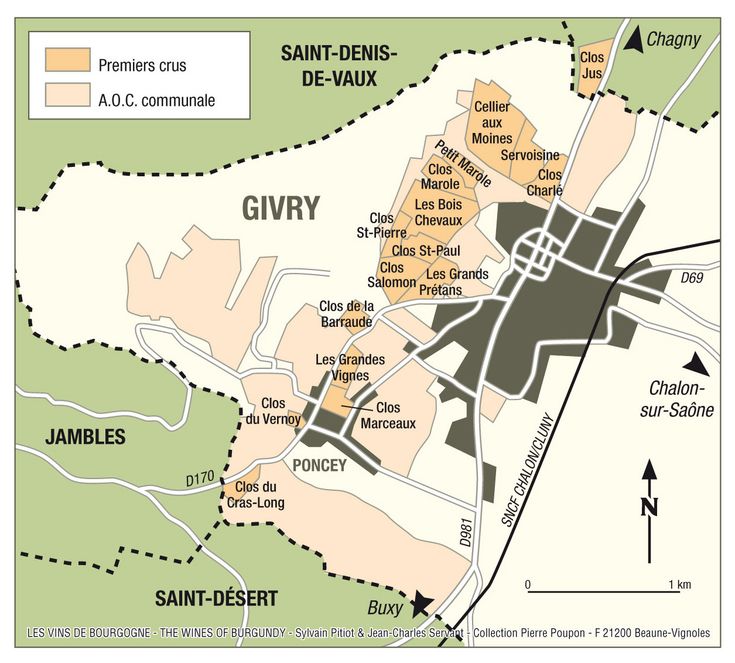Given the current fashion for everything Burgundian, the underestimated village of Givry should be at the top of the list for those seeking high-quality Burgundy that doesn’t require a bank loan to buy. It’s a historic
terroir with tremendous potential and talented producers pushing the limits of what’s possible here in the central-eastern part of the Côte
Chalonnaise region.
The first vineyards in Givry date to Roman times, but their renown began in earnest with the establishment of Ferté abbey in 1113AD. Ferté was
founded by the monks of Cîteaux, near Dijon, who also built the Clos de Vougeot at roughly the same time. The wines’ reputation gradually grew,
and by the 14th century, wines from Givry were served at the table of Pope Clement VI in Avignon. Although the original Ferté abbey was
destroyed during the 16th-century Wars of Religion, wine production continued to thrive.
By the 18th century, the priest-historian Claude Courtépée called Givry the best wine of the Côte Chalonnaise, noting that it had been the everyday wine of King Henri IV. Givry was still prized in the years following the French Revolution, and in 1832, noted authority André Jullien praised its
finesse and bouquet.
The latter years of the 19th century, however, brought scourge after scourge to the region. Jacky Rigaux’s comments in the informative work La
Côte Chalonnaise (October 2018, de Monza/du Meurger) tell us that grape moths were followed by powdery mildew (oidium) and finally by the
phylloxera bug. Efforts to combat these problems were not always successful. Noted Givry vigneron Baron Paul Thénard tried injecting the soil with carbon disulfide to kill phylloxera, while others tried planting direct-producing hybrids. To meet demand, the growers also planted easy-to-grow Gamay. These ineffective efforts damaged Givry’s reputation, and the village did not receive its AOC (appellation d’origine contrôlée) until 1946, and premier cru status vineyards were not recognised
until 1990, despite the long history of some sites.
Historic Landscape
Today things are beginning to change, and new investment is pouring into the region. Philippe Pascal, former CEO of Veuve Clicquot and
LVMH’s watch and jewellery division has invested to revive the vines of Ferté abbey, today called the Domaine du Cellier aux Moines.
Others are also working to raise the bar, and the region has enormous natural potential.
The slopes of the Côte Chalonnaise were created by the faults caused by the uplifted block of granite called the Horst de Mont St-Vincent.
The east- and southeast-facing hills formed here are less homogenous than those in the Cote d’Or further north, but this diversity can also be a
strength. Some areas that have more marl and slopes facing west are suitable for Chardonnay while those that have more limestone and slopes
facing east/southeast are more suitable for Pinot Noir. The appellation includes two small villages in addition to Givry itself – Dracy-le-Fort in the
north and Jambles in the south. There are also hamlets that are part of Givry including Poncey and Russilly.
Slopes in the northern part of the appellation are mostly east-facing, such as the premier cru vineyard Clos Jus in Dracy, above the main road
called the Route de Buxy (D981). The vines beneath the road are split between premier cru and village appellations. Just to the south, steep slopes form a cirque or amphitheatre that surrounds the bustling
village of Givry. This area includes the Premiers Crus La Servoisine and the Clos du Cellier aux Moines with their south-facing vines looking over
the village. In contrast, the hills west of the village face southeast and include the premiers crus Les Bois Chevaux and Clos Salomon, separated by the valley called La Combe Gris.
The vineyards south of the village are divided by the valley from Poncey to Russilly. The vines surrounding Jambles and Russilly face mostly
south, while those on the flat land that leads to the N80 motorway are inclined slightly northeast.

Evolution and Expanssion
The key to an overall understanding of the appellation is the elevation. It varies from 200m-410m, with village Givry appellation vines
at the top and the base of the slope and the premiers crus running northeast-southwest along the prime mid-slope section. The top of the slope features hard limestone from the Jurassic period, and deeper marly soils are at the bottom.
The Givry appellation has been expanded several times. The original appellation was created for the vineyards that existed at the end of World War II. Authorities defined the appellation according to scientific criteria in
1988, and established an initial list of premiers crus in 1990 covering 16 climates. The list was expanded to all or part of 26 climates in 1997 and
expanded again to the present 38 in 2010. The style of the wine of Givry has also evolved.
Once, the wines were rustic, with astringent tannins, earthy notes instead of fruit, and sharp acidity. Today the fruit is riper due to global warming, and advances in grape-growing and winemaking have given us wines with more elegance and finesse. The balance found in Givry now is superb, with tannins that are not as firm as one can find in Mercurey, for example, but with more structure than is common in other parts of the Côte Chalonnaise.
With the excitement and investment Givry has seen in recent years, this is one of the best places to search for top-quality, value-priced Burgundy.